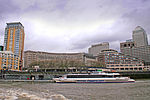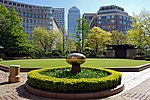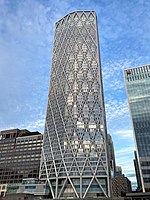Canary Riverside Plaza

Canary Riverside Plaza Hotel is a luxury 5-star hotel in London, England. It is located at 46 Westferry Circus in Canary Wharf. The hotel has 142 rooms and suites containing large bay windows overlooking the River Thames. Its Ancient Egyptian inspired design by Renton, Howard, Wood & Levin, based on earlier work by Philippe Starck, features a curved patinated copper roof. This bold architecture was seen as a departure from the previous conservatism of the Four Seasons group, who built it as Four Seasons Hotel London at Canary Wharf.It is owned by the Monaco-based billionaire property developer John Christodoulou.The mixed-use site has been the subject of much litigation and controversies between the landlord and leaseholders. In 2016, the residential leaseholders won the right to have a court appointed manager installed due to a lack of financial transparency, extortionate service charges and a failure to maintain the estate by landlord Yianis Group. Over 100 of the residents were threatened with defamation for appealing to judges for the removal of the landlord with a section 24 manager. However, Christodoulou began to "chip away at the manager’s powers, costing leaseholders £1m in legal fees in 22 proceedings", eventually forcing the first court appointee to quit on health grounds.
Excerpt from the Wikipedia article Canary Riverside Plaza (License: CC BY-SA 3.0, Authors, Images).Canary Riverside Plaza
Westferry Circus, London Limehouse
Geographical coordinates (GPS) Address Nearby Places Show on map
Geographical coordinates (GPS)
| Latitude | Longitude |
|---|---|
| N 51.50609 ° | E -0.0281 ° |
Address
Westferry Circus 32
E14 8RH London, Limehouse
England, United Kingdom
Open on Google Maps








